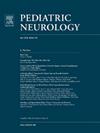Developmental, Endocrine, and Ophthalmologic Outcomes in Children Prenatally Diagnosed With Midline Brain Malformations
IF 3.2
3区 医学
Q2 CLINICAL NEUROLOGY
引用次数: 0
Abstract
Background
Midline brain malformations (MBMs) are commonly prenatally diagnosed and associated with endocrinologic, ophthalmic, and adverse developmental outcomes.
Methods
A retrospective review was conducted of all neonates identified prenatally with suspected MBMs between 2018 and 2022 at the only multidisciplinary referral center in a multistate region. Abnormalities were categorized as isolated versus complicated absent cavum septum pellucidum (ASP) (N = 11 vs N = 13) or corpus callosum abnormalities (AgCC) (N = 11 vs N = 43) or holoprosencephaly spectrum (N = 12). We assessed subsequent diagnoses and outcomes using a standardized assessment pathway.
Results
Infants with holoprosencephaly were significantly more likely to die than patients with isolated ASP or AgCC (P = 0.02). Surviving infants with holoprosencephaly had universal developmental delay, significantly more than the 10% seen in isolated ASP or AgCC (P = 0.007), and infants with isolated MBMs were significantly more likely to be alive and without endocrine, ophthalmologic, developmental, or epileptic diagnoses at last follow-up than other groups (isolated ASP = 67%, AgCC 82%). The median time to diagnosis of optic nerve hypoplasia was 3 days and initial identification of endocrine concerns was 7 days. There were no significant differences between rates of diagnosis for endocrine, ophthalmologic, or epileptic complications between groups, with all MBMs demonstrating a risk for complications.
Conclusions
Our study shows the importance of multidisciplinary screening in all infants with midline brain defects. Most infants with isolated ASP or AgCC did not have MBM-associated diagnoses at last follow-up, but all groups had comorbidities and would benefit from multispecialty postnatal monitoring.
产前诊断为中线脑畸形儿童的发育、内分泌和眼科预后
背景:中线脑畸形(MBMs)通常在产前被诊断出来,并与内分泌、眼科和不良发育结果相关。方法回顾性分析某多州地区唯一的多学科转诊中心2018 - 2022年间产前诊断为疑似MBMs的所有新生儿。异常分为孤立性与复杂性透明隔空缺失(ASP) (N = 11 vs N = 13)或胼胝体异常(AgCC) (N = 11 vs N = 43)或前脑畸形谱(N = 12)。我们使用标准化评估途径评估后续诊断和结果。结果无前脑畸形患儿的死亡率明显高于单纯ASP或AgCC患儿(P = 0.02)。存活的全前脑畸形婴儿普遍发育迟缓,明显高于分离性ASP或AgCC的10% (P = 0.007),分离性MBMs的婴儿在最后随访时没有内分泌、眼科、发育或癫痫诊断的可能性明显高于其他组(分离性ASP = 67%, AgCC 82%)。诊断视神经发育不全的中位时间为3天,初步确定内分泌问题的中位时间为7天。两组间内分泌、眼科或癫痫并发症的诊断率无显著差异,所有MBMs均有并发症风险。结论我们的研究显示了多学科筛查对所有中线脑缺陷婴儿的重要性。大多数患有孤立性ASP或AgCC的婴儿在最后随访时没有mbm相关的诊断,但所有组都有合并症,并将受益于多专业的产后监测。
本文章由计算机程序翻译,如有差异,请以英文原文为准。
求助全文
约1分钟内获得全文
求助全文
来源期刊

Pediatric neurology
医学-临床神经学
CiteScore
4.80
自引率
2.60%
发文量
176
审稿时长
78 days
期刊介绍:
Pediatric Neurology publishes timely peer-reviewed clinical and research articles covering all aspects of the developing nervous system.
Pediatric Neurology features up-to-the-minute publication of the latest advances in the diagnosis, management, and treatment of pediatric neurologic disorders. The journal''s editor, E. Steve Roach, in conjunction with the team of Associate Editors, heads an internationally recognized editorial board, ensuring the most authoritative and extensive coverage of the field. Among the topics covered are: epilepsy, mitochondrial diseases, congenital malformations, chromosomopathies, peripheral neuropathies, perinatal and childhood stroke, cerebral palsy, as well as other diseases affecting the developing nervous system.
 求助内容:
求助内容: 应助结果提醒方式:
应助结果提醒方式:


